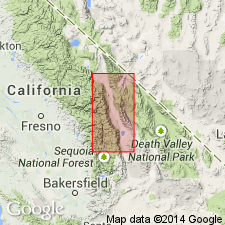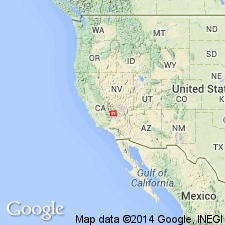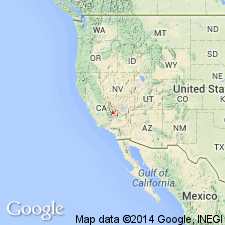
- Usage in publication:
-
- Reward conglomerate*
- Modifications:
-
- Original reference
- Dominant lithology:
-
- Conglomerate
- AAPG geologic province:
-
- Great Basin province
Summary:
Reward conglomerate. Conglomerate of coarse material, of both angular and rounded fragments of red, brown, and white grits, together with jasper, brown hornstone, and green cherty pebbles firmly held together by a siliceous cement. A brownish-weathering sandstone with dark-brown patches and layers forms uppermost 100 feet of the Reward north of Union Wash. Thickness of formation 100 to more than 350 feet. Unconformably underlies Owenyo limestone (Permian), and conformably overlies Pennsylvanian limestone and shale. Age is Pennsylvanian.
Named from bold exposures just south of Reward Mine, [Inyo Mountains, Inyo Co.], eastern CA.
Source: US geologic names lexicon (USGS Bull. 896, p. 1800).

- Usage in publication:
-
- Reward conglomerate member*
- Modifications:
-
- Revised
- AAPG geologic province:
-
- Great Basin province
Summary:
Pg. 8, 10. Reward conglomerate member of Owens Valley formation. Reduced to member status in Owens Valley formation (new). Age is Permian.
Source: US geologic names lexicon (USGS Bull. 1200, p. 3251-3252).

- Usage in publication:
-
- Reward Conglomerate Member*
- Modifications:
-
- Revised
- AAPG geologic province:
-
- Great Basin province
Summary:
Pg. 3, 5-7. Reward Conglomerate Member of Lone Pine Formation of Owens Valley Group. Reassigned to Lone Pine Formation (new) as its uppermost member. Is a cliff-forming unit consisting mainly of thick-bedded, medium- to coarse-grained quartzite and chert-pebble conglomerate. Cross-bedding and scour structure are common. Lowermost part marked by a thin, persistent zone of light-gray sandy marble. Thickness 0 to about 200 m. Overlies informal member C of the Lone Pine. Underlies with angular unconformity Conglomerate Mesa Formation (new) of Owens Valley Group. Present in Reward Mine-Union Wash area, [in NE/4 Union Wash 7.5-min quadrangle, Inyo Co., eastern CA]; is truncated to southeast (not present at Lone Pine type). Fossils; poorly preserved Wolfcampian or Leonardian fusulinds recovered from basal part of member. Age is considered late Early Permian.
Type locality not designated by Kirk but authors consider it to be about 1 km south of Reward Mine, in NE/4 T. 14 S., R. 36 E., Union Wash 7.5-min quadrangle, Inyo Co., eastern CA. A better section is present about 0.5 km southeast of Fossil Hill, where both the stratigraphic base and the unconformably truncated top of the Reward Conglomerate Member are exposed.
Source: Publication.
For more information, please contact Nancy Stamm, Geologic Names Committee Secretary.
Asterisk (*) indicates published by U.S. Geological Survey authors.
"No current usage" (†) implies that a name has been abandoned or has fallen into disuse. Former usage and, if known, replacement name given in parentheses ( ).
Slash (/) indicates name conflicts with nomenclatural guidelines (CSN, 1933; ACSN, 1961, 1970; NACSN, 1983, 2005, 2021). May be explained within brackets ([ ]).

